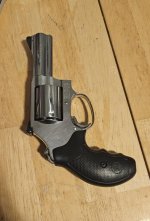Hi,
Quick preface:
-I'm not a gun smith, I don't even play one on TV.
-I'm fairly familiar with basic maintenance and I'll say 'non-invasive customization' of semi-automatic pistols.
-My revolver knowledge is extremely limited so forgive any poor nomenclature.
-I don't actually know the model of the firearm (though i have pictures). Engravings show a caliber on barrel left, Smith And Wesson on barrel right, and some brand info below the cylinder on the right side. I thought this was weird and I checked 2 smith revolvers I have (hand me downs) and neither of those have a model number on it either at least not that I saw. FWIW, I think one of them is a model 15, the other is some flavor of a snub nosed .38 and both are prehistoric.
The background:
-A lady friend keeps a smith revolver for home defense. We were going to the range because what else do you do after brunch on a Saturday.
-Prior to going, I picked up the revolver, inspected the cylinder to see if it was loaded, determined it was unloaded and decided to dryfire.
-Upon trigger pull, the hammer came all the way back. The trigger wouldn't break. It's just "stuck".
-There is no discernible give in the trigger or the hammer, nor is there give in the hammer while attempting to manipulate the trigger as though I were trying to do a safe decock.
-I can no longer open the cylinder. I'm assuming this is because the hammer is back and this is by design.
-I don't know it for a fact, but I'd say there's a good chance that this is a sock drawer gun. Probably neither fired nor maintained often if at all
If anybody is curious, we did end up going to the range anyway. I rather like this one, so I did not hand her my 320.
So my question: What if anything should I do?
-If this sort of thing happens due to lack of maintenance and there's a maintenance procedure that a schmoe can do, I'd probably give it a go.
-If this sounds like a more complex problem, I'd probably try to locate a competent gun smith, but i don't even know where i'd start to look for a smith wheel gun guy/gal.
-I am confident that the firearm was not loaded when I started manipulating it because I'm something of a nut about checking the condition of my firearms. However, I can't do any sort of safe inspection right now without pointing a malfunctioning weapon at my noggin like an idiot. What approach would more experienced revolver guys use to check the status?
Quick preface:
-I'm not a gun smith, I don't even play one on TV.
-I'm fairly familiar with basic maintenance and I'll say 'non-invasive customization' of semi-automatic pistols.
-My revolver knowledge is extremely limited so forgive any poor nomenclature.
-I don't actually know the model of the firearm (though i have pictures). Engravings show a caliber on barrel left, Smith And Wesson on barrel right, and some brand info below the cylinder on the right side. I thought this was weird and I checked 2 smith revolvers I have (hand me downs) and neither of those have a model number on it either at least not that I saw. FWIW, I think one of them is a model 15, the other is some flavor of a snub nosed .38 and both are prehistoric.
The background:
-A lady friend keeps a smith revolver for home defense. We were going to the range because what else do you do after brunch on a Saturday.
-Prior to going, I picked up the revolver, inspected the cylinder to see if it was loaded, determined it was unloaded and decided to dryfire.
-Upon trigger pull, the hammer came all the way back. The trigger wouldn't break. It's just "stuck".
-There is no discernible give in the trigger or the hammer, nor is there give in the hammer while attempting to manipulate the trigger as though I were trying to do a safe decock.
-I can no longer open the cylinder. I'm assuming this is because the hammer is back and this is by design.
-I don't know it for a fact, but I'd say there's a good chance that this is a sock drawer gun. Probably neither fired nor maintained often if at all
If anybody is curious, we did end up going to the range anyway. I rather like this one, so I did not hand her my 320.
So my question: What if anything should I do?
-If this sort of thing happens due to lack of maintenance and there's a maintenance procedure that a schmoe can do, I'd probably give it a go.
-If this sounds like a more complex problem, I'd probably try to locate a competent gun smith, but i don't even know where i'd start to look for a smith wheel gun guy/gal.
-I am confident that the firearm was not loaded when I started manipulating it because I'm something of a nut about checking the condition of my firearms. However, I can't do any sort of safe inspection right now without pointing a malfunctioning weapon at my noggin like an idiot. What approach would more experienced revolver guys use to check the status?

